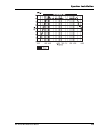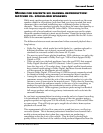
Surround Sound
32 M1 Active Reference Manual
CENTER SPEAKERS IN MUSIC MIXES
In video applications, with left, center and right channels all set to deliver
equal output, the ear tends to hear dialog as coming only from the center
channel. (It’s a psychoacoustic effect because all right and all left channel
signals are fed to the center.)
In Dolby Pro Logic, the center channel information is derived from sum and
difference information encoded in the left and right channels. The very
attributes that make this matrix-type system viable for video application
make it less desirable for music-only reproduction. In practice, there is a hard
center dialog channel but there is also a sort of phantom mono channel
developed between the left and center channel and the right and center
channel. This between-channel phantom mono image exists because so much
of the information contained in each channel (left and center or right and
center) is identical. Hence, mono. In the few music-only recordings encoded
in Dolby Pro Logic, the derived center channel could lead to some drastic
changes in spatial perception.
In developing the M1 Active Mk2s for use as left, center and right front
channel sources, we wanted them to be useable in both audio/video and
audio-only “matrix” type applications. We discovered two, already available
solutions to the large “wall-of-mono” effect produced by Dolby Pro Logic
when playing audio-only material. The first is easy. Most home audio Dolby
Pro Logic receivers will let you take the center channel out completely by
putting the receiver in the “phantom” (no center channel) mode. It preserves
the classic stereo effect of the front channels while adding rear surround.
This method works well with most stereo-only recordings which have no
surround encoding. But it’s much better if the rear channels have true matrix
(mono) surround (like applause) encoded in the mix.
The second method of using Dolby Pro Logic gets the center channel back
into the mix. Most of these same home audio receivers have an audio-only
surround mode which significantly attenuates the output of the center
channel in relation to the left and right. The audible benefit here is that the
mix sounds like a stereo only recording but the center image (like a vocalist)
becomes a hard center. There is no image wander, as the frequencies change,
for instance. And the classic listening “sweet spot” expands dramatically,
allowing for accurate soundstage and instrument placement when listening
far off-axis. (This attenuating of the center channel for audio only is also
employed by advanced professional matrixed decoders such as the Circle
Surround, Miles Technology and Lexicon units.)


















